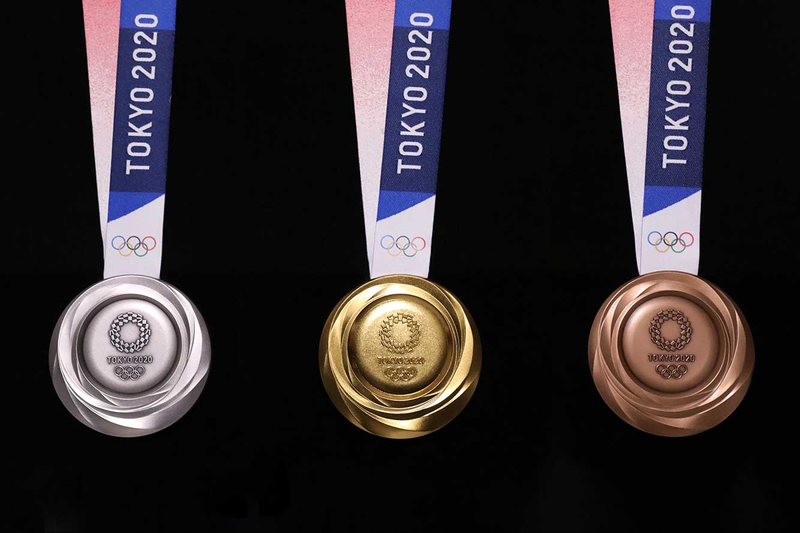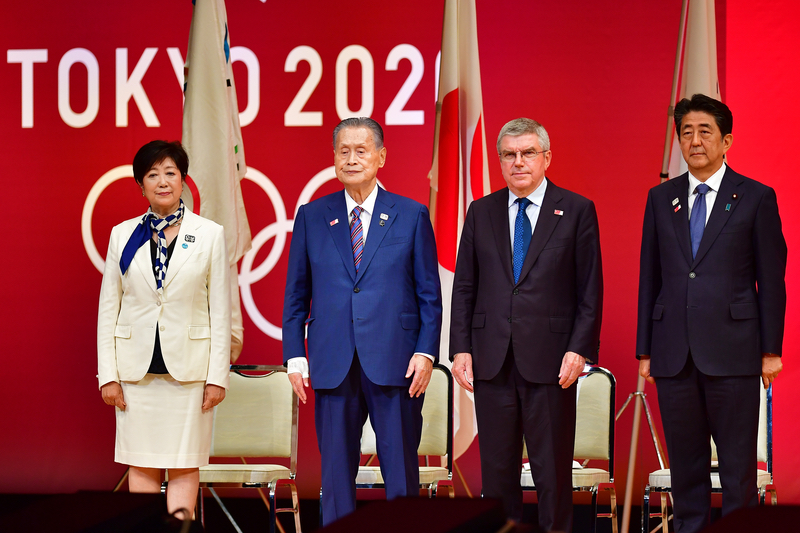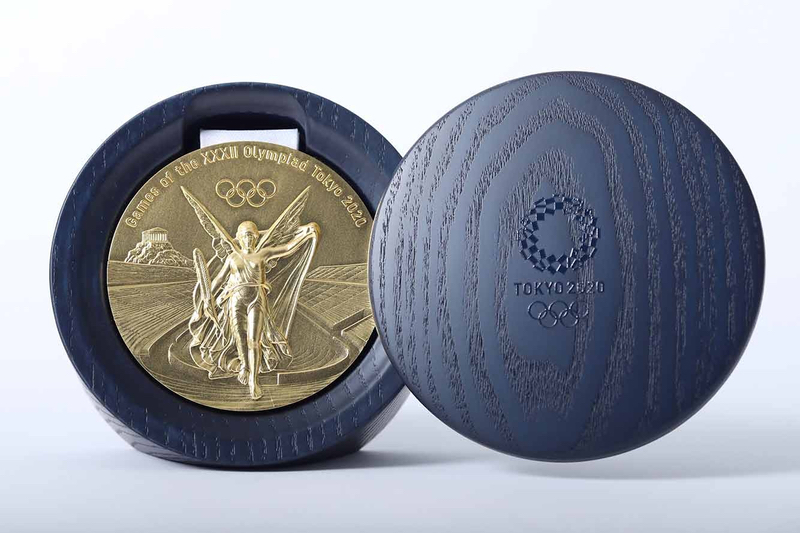
#The medals resemble rough stones that have been polished and which now shine
The design for the Tokyo 2020 Olympic medals were unveiled on Wednesday, exactly one year to the event’s opening ceremony, during a special countdown occasion held at the Tokyo International Forum.
This medal design, selected from more than 400 design applications submitted to the Tokyo 2020 medal design competition open to professional designers and design students, resembles rough stones that now shine after being polished.
“LIGHT” AND “BRILLIANCE” The concept reflects the hard work an athlete puts into achieving glory, with “light” and “brilliance” as the overall theme. “The medals collect and reflect myriad patterns of light, symbolising the energy of the athletes and those who support them; their design is intended to symbolise diversity and represent a world where people who compete in sports and work hard are honoured. The brilliance of the medals’ reflections signifies the warm glow of friendship depicted by people all over the world holding hands,” according to organisers.
Just as the International Olympic Committee (IOC) regulations stipulate, the front of Olympic medal features Nike, the Greek goddess of victory alongside the official name of the Games, and the Olympic five rings symbol.
Junichi Kawanishi, who won the nationwide medal design competition, said: “I never dreamed that the design I submitted, only as a memorial to this lifetime event, would be actually selected. With their shining rings, I hope the medals will be seen as paying tribute to the athletes’ efforts, reflecting their glory and symbolizing friendship.”
 SUSTAINABILITY To promote sustainability, the Tokyo Organising Committee of the Olympic and Paralympic Games (Tokyo 2020) introduced the “Tokyo 2020 Medal Project” which lasted two years between 1 April 2017 to 31 March 2019.
SUSTAINABILITY To promote sustainability, the Tokyo Organising Committee of the Olympic and Paralympic Games (Tokyo 2020) introduced the “Tokyo 2020 Medal Project” which lasted two years between 1 April 2017 to 31 March 2019.
The project saw the collection of small electronic devices such as used mobile phones from all over Japan, which would be recycled into the medals to be used at next year’s Olympic and Paralympic Games. Over 90% of Japanese cities, towns and villages participated in the collection phase of the project.
Hence, 100 per cent of the gold, silver and bronze elements required to produce the approximately 5,000 medals have been extracted from the used small electronic devices. The campaign generated roughly 32 kilograms of gold, 3,500kg of silver and 2,300kg of bronze. “We hope that our project to recycle small consumer electronics and our efforts to contribute to an environmentally friendly and sustainable society will become a legacy of the Tokyo 2020 Games,” organisers said.
CASE AND RIBBON The medal’s case and ribbon were also revealed on Wednesday. While the cases are made from Japanese ash wood dyed with the same colour as the Olympic emblem, the ribbons were inspired by traditional Japanese patterns and kimono-layering techniques.
Ryohei Miyata, chairperson of the Tokyo 2020 medal design selection panel, said: “I am convinced that Japanese metal molding techniques and the superb design have combined well, and that we have the best medal in the world – one that we can be proud of. There is also a beautiful balance between the design of the medals and their ribbons. It makes me want to strive for a medal myself.”

MAKING HISTORY Tokyo is spending at least $20 billion to get ready for the games, although the exact Olympic spending is disputed and difficult to track. Five of the eight new venues have been completed, and the centerpiece, the $1.25 billion National Stadium, is to open by the November.
IOC president Thomas Bach believes that Japan will make history next year with the Games. He was speaking at the countdown ceremony in Tokyo. “When the Olympic Games Tokyo 2020 get under way, the eyes of the world will be on Japan. The preparations are making excellent progress. I can truly say I have never seen an Olympic city as prepared as Tokyo with one year to go before the Olympic Games,” he added.
EXCITEMENT Ticket demand by Japanese residents have been overwhelming, with more than 7.5 million people registering for the first ticket lottery in June, of which around 3.2 million tickets were sold according to the Organising Committee.
Two more rounds have been scheduled for later this year to accommodate applicants that were unsuccessful in the first ballot. Meanwhile, over 200,000 people in Japan and abroad have applied to the be volunteers at the event
With reference to the interest in ticket sales, John Coates, who heads the IOC inspection team for Tokyo, said, “the excitement is growing.”
EXTREME HEAT Organizers are also preparing for Tokyo’s typically hot summer weather. It has been one of the biggest concerns ahead of the event after a record heat wave in July 2018 killed over a dozen people in the Japanese capital.
One of the measures being considered to counter the extreme heat is allowing spectators to bring their own bottled water into venues. This had previously been prevented at past editions of the Olympic Games due to security and sponsorship.
“Discussions were taken here to confirm that spectators will be allowed to take their own water into venues, the coverage for folk lining up to get into venues was explained and looks good,” Coates explained on Tuesday. He also mentioned air-conditioned lounges for the athletes and ice baths at the athlete village and at the venues.
ANTI-OLYMPIC ACTIVISTS However, the thought of Tokyo 2020 does not excite everyone. A group of anti-Olympic activists have, through small protests under the Japanese title “Hangorin no Kai” — which translates roughly to No Olympics – strongly opposed the Olympic spending.
“For us, the Olympics are a disaster,” Misako Ichimura, a spokeswoman for the anti-Olympic group, said on Tuesday. She said the billions spent on the Olympics should be used instead in to rebuild Fukushima, which was devastated by a 2011 earthquake, tsunami and the meltdown of three nuclear reactors.”
A few days ago, Tokyo governor Yuriko Koike was asked to justify spending billions on the Olympics, and she said: “I’d like the legacy of the 2020 Games to be something more intangible, a new way of thinking for people and for society,” she said. Koike described the Paralympics, which open Aug. 25, 2020, as a “springboard” to make the city more accessible to people with disabilities.”
CHALLENGES Organizers have been under pressure to cut costs, and they say they have cut billions by using existing venues. Tokyo is building eight new venues, but using 35 “temporary” or older venues.
A futuristic design for the new stadium by the-late British architect Zaha Hadid was abandoned when costs soared to $2 billion. Japanese architect Kengo Kuma was then chosen with a design focused on wood lattice and greenery.
Indeed, Tokyo 2020 has had its fair share of challenges and scandals, which include redesigning their logo when the original draft faced charges of plagiarism, and the resignation of Tsunekazu Takeda, the head of the Japanese Olympic Committee, when he was implicated in a vote-buying scheme to land the games.
In any case, Tokyo 2020 organisers say they are on track to deliver the games on time. They have shattered records for local sponsorship revenue, raising $3.1bn in sponsorship from 62 Japanese firms – around triple what was obtainable at any previous Games.































